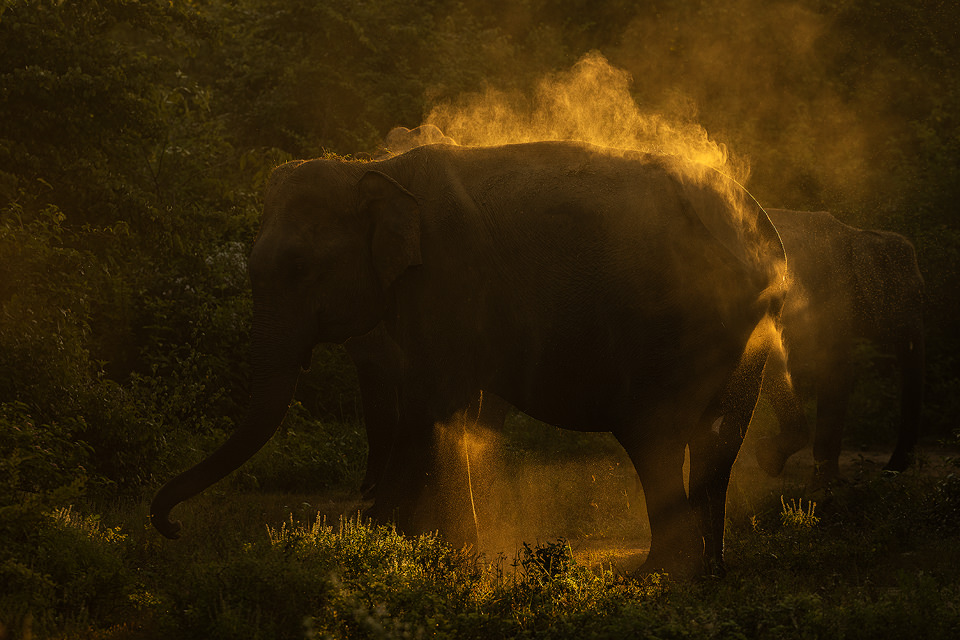Backlit Asian Elephant
Backlit Asian Elephant. An Adult Sri Lankan elephant having a dust bath, backlit by stunning early morning light. Udawalawe National Park in Sri Lanka
Backlit Asian Elephant – About the Asian Elephant:
The Asian elephant (Elephas maximus), also known as the Asiatic elephant, is the largest living land mammal in Asia. There are Three recognised subspecies of Asian Elephant including, Indian elephants, Sri Lankan Elephants and the Sumatran elephant.
Asiatic elephants inhabit forest and grasslands throughout Central and South Asia. Elephants are extremely sociable animals and typically live in groups of related females and their young that are led by the oldest female, the matriarch. These groups are sometimes accompanied by the more solitary bulls and occasionally join others to form large herds. In Asia, elephant herd sizes are significantly smaller than those of savannah elephants in Africa.
Asiatic Elephants are slightly smaller and lighter than their African cousins. African bull Elephants can grow up to 4 meters tall, whereas the biggest Asian males only reach 3.5 meters. Because of this size difference adult African elephants weigh between 4,000 and 8,000kg, whilst Asian elephants weigh between 3000 and 6,000kg.
Other differences include ear and head shape and the ability to grow prominent tusks. Both male and female African elephants grow protruding tusks whereas only some male Asian elephants can grow prominent tusks.
Elephants primarily feed on grasses, but their diet also includes tree bark, roots, leaves, and stems. Cultivated crops such as bananas, rice, and sugarcane have become particular favourites, bringing them into conflict with humans.
Elephants are vital to their ecosystems. They are the natural architects of the forest, helping to maintain the health of forest and grassland habitats. Their enormous size and weight allows them to create of pathways and clearings in the dense forests creating access for other plant and animal wildlife.
Asian elephants may spend up to 19 hours a day feeding. During this time they can cover up to 125 square miles and produce a huge amount of dung helping to disperse germinating seeds widely.
Elephants are highly intelligent, and sociable animals. They can communicate over vast distances using a range of low-pitched sounds that are barely audible to humans. These powerful infrasonic rumbles contain specific messages that can be heard and understood by other elephants more than 2 miles away!
Over the centuries in Asia, humans have had a close and lasting relationship with elephants. In particular Indian elephants have become important cultural icons. In Hinduism, the powerful deity honoured before all sacred rituals is the elephant-headed Lord Ganesha, who is also called the Remover of Obstacles.
Asiatic Elephant Conservation:
Asian elephants are listed as Endangered by the IUCN. The total population is estimated to be between 37,000 and 57,000 animals. This estimate has such a wide range due to the extreme difficulty involved in trying to survey a population that is difficult to find in the dense jungles of Asia.
At one time, Asian elephants ranged from Syria and Iraq east across the whole of Southern Asia and North into China. Although still widespread, Asiatic elephant populations are now highly fragmented and under extreme pressure. India is currently home to by far the largest population of elephants, with almost half of the total population of Asian elephants living within its borders.
Poaching for ivory does not threaten Asian elephant to the same extent as the African elephant. This is because many male Asian elephants are tuskless. However, poaching of tuskers in southern India for both ivory and meat is still a serious problem and has had a radical effect on breeding patterns.
Because elephants require much larger habitats than most other terrestrial mammals, they are the first to suffer the consequences of habitat fragmentation and destruction. Due to the ever expanding human population and our incessant demands, elephants have been forced to adapt their lifestyle. Crop raiding by herds of elephant is frequent and creates situations that lead to both elephant and human casualties.
In some countries, the government provides compensation for crop damage or deaths caused by elephants, but there is still often strong political pressure on wildlife authorities to eliminate elephants near populated regions. As human populations increase, elephant-human conflicts are likely to rise. In India, about 300 people and 200 elephants per year die through poaching, crop protection incidents or automobile related accidents.
The future of wild Asian elephants depends on the continuation of the ivory ban, habitat preservation, devising ways for people and elephants to co-exist together and successful zoo breeding programs around the world. The Asian elephant is an ecological umbrella species, whose survival would help maintain biological diversity and promote ecological integrity.
You can find more about Asian Elephants here.
